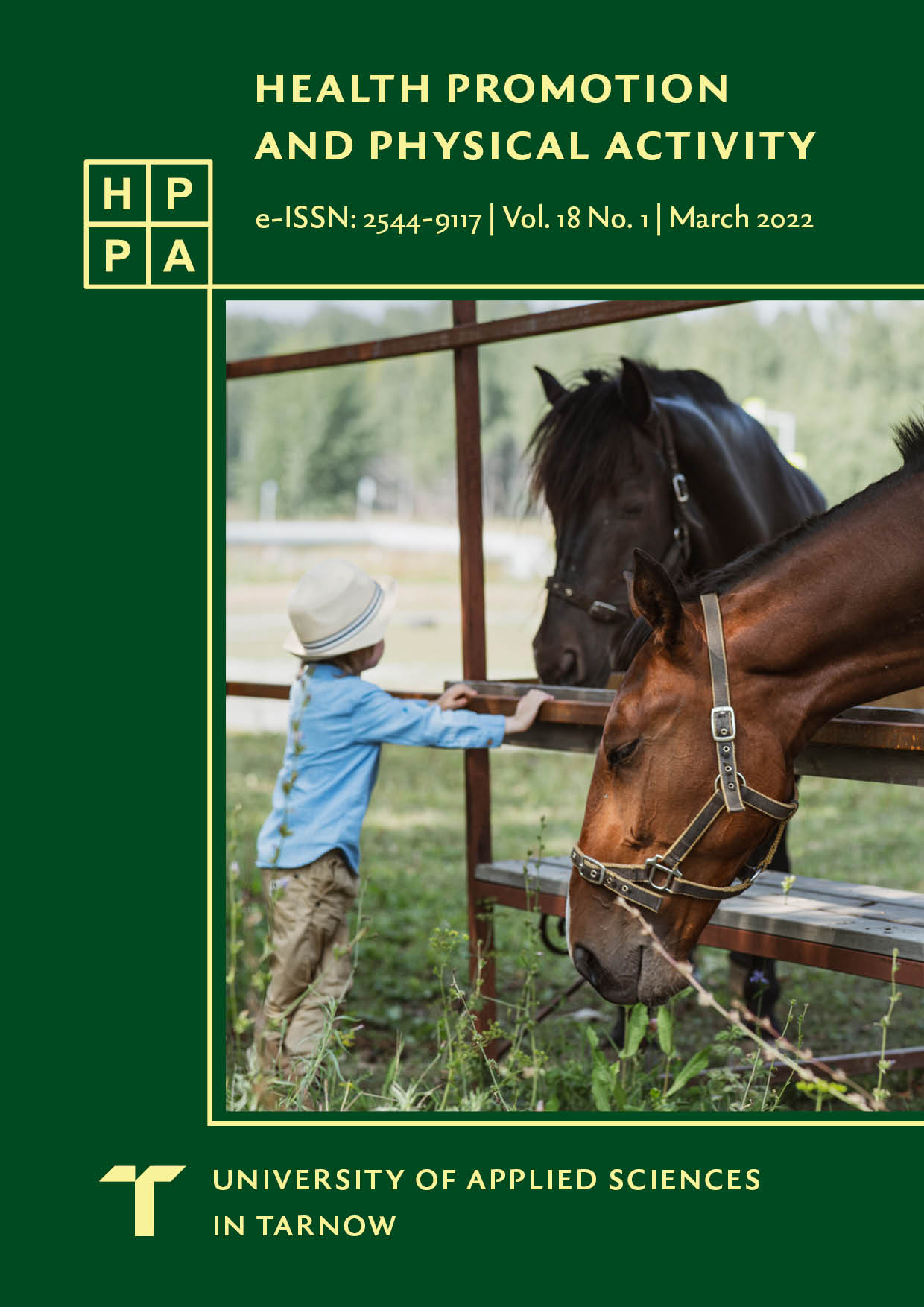Hippotherapy as a way of improving motor performance in juveniles with infantile cerebral palsy
DOI:
https://doi.org/10.55225/hppa.368Keywords:
hippotherapy, infantile cerebral palsy, therapy, movement, therapeutic interventionAbstract
Animals have accompanied man for thousands of years and their role in human life has seriously evolved. Man had power over domesticated animals and decided about their fate, they were used as a means of transport and helped humans with the farming. There is a group of animals, known as companion animals, which are ranked high in human life. Nowadays, animals are more frequently utilized in different animal-assisted therapies. Hippotherapy as a therapeutic intervention exerts serious influence on those participating in its sessions, and it affects all interpenetrating spheres of human life. Therapeutic effects of horse-riding were already known in 400 B.C. Hippocrates claimed that horse-riding exerted positive effect on treating certain health conditions.
Equine therapists, over the years, have noticed significant benefits to their clients resulting not only from the nature of a horse but also from its unique ambulation. One can say that a horse during a therapeutic session becomes a precise stimulator of movement.
Thanks to a similar way of ambulation in man and in a horse, during a horse riding session the rider’s pelvis, trunk and the shoulder girdle are made to move according to the physiological pattern of human ambulation, so a person with motor disorders has a chance to learn proper human gait pattern without walking.
Downloads
References
Arusztowicz B, Bąkowski W. Dziecko niepełnosprawne z dysfunkcją narządu ruchu. Kraków: Impuls; 2001. Google Scholar
Bekasiewicz N. Czy zwierzęta potrafią leczyć? Terapie z udziałem zwierząt wspomagające rehabilitację osób niepełnosprawnych. Warszawa: Fundacja Pomocy Osobom Niepełnosprawnym Przyjaciel; 2008. Google Scholar
Grochmal S. Narodziny hipoterapii. Hipoterapia. 1992;4(4):4-6. Google Scholar
Białoszewski D, Korabiewska I, Lewandowska M, Wasiak K. Ocena przydatności hipoterapii w rehabilitacji dzieci z mózgowym porażeniem. Doniesienie wstępne. Fizjoter. Pol. 2011;11(2):175-181. Google Scholar
Charkiewicz M. Bezpieczeństwo podczas zajęć terapeutycznych z udziałem zwierząt. Przegląd Hipoterapeutyczny. 2011;1:12-20. Google Scholar
Czerwińska K. Psychopedagogiczne aspekty hipoterapii dzieci i młodzieży niepełnosprawnych intelektualnie – recenzja. Szkoła Specjalna. 2003;4:253-254. Google Scholar
Dega W, Milanowska K. eds. Rehabilitacja medyczna. Warszawa: Wydawnictwo Lekarskie PZWL; 1998. Google Scholar
Dziuba A, Bober T, Wójtowicz D. Siodło BABS do rehabilitacji dzieci z mózgowym porażeniem dziecięcym jako uzupełnienie ćwiczeń hipoterapii. Post. Rehab. 1999; 4(13):123-135. Google Scholar
Kamińska A, Mazur A. Metodyka zajęć hipoterapeutycznych dla dzieci z mózgowym porażeniem dziecięcym. Postępy Rehabilitacji. 1998;12(3):85-93. Google Scholar
Kamińska U, Nowak J. Hipoterapia jako metoda rehabilitacji medycznej i psychopedagogicznej. Auxilium Sociale. 1997;3-4:49-62. Google Scholar
Anwajler J, Lwosz A, Małachowska-Sobieska M, Ostrowska B, Skolimowski T. Ocena skuteczności oddziaływania korekcyjnego hipoterapii neurofizjologicznej na ustawienie tułowia dzieci z mózgowym porażeniem typu wiotkiego. Fizjoterapia. 2004;12(2):23-32. Google Scholar
Milanowska K. Kinezyterapia. Warszawa: Wydawnictwo Lekarskie PZWL; 2006. Google Scholar
Strumińska A. Psychopedagogiczne aspekty hipoterapii. Warszawa: Państwowe Wydawnictwo Rolnicze i Leśne; 2003. Google Scholar
Suwińska-Osińska M. Rola hipoterapii w procesie rehabilitacji społecznej osób z niepełnosprawnością intelektualną w stopniu umiarkowanym i znacznym. Przegląd Hipoterapeutyczny. 2011;1:39-42. Google Scholar
Szymczak M. Wpływ zajęć hipoterapeutycznych na rozwój dzieci z mózgowym porażeniem dziecięcym. Pielęgniarstwo Polskie.2009;4(34):282-285. Google Scholar
Weis M, Zębaty A. Fizjoterapia dla medycznych studiów zawodowych. Warszawa: Wyd. Fizjoterapii PZWL; 1998. Google Scholar
Zabłocki KJ. Mózgowe porażenie dziecięce w teorii i terapii. Warszawa: Wydawnictwo Akademickie Żak; 1998. Google Scholar
Strau BI. Hipoterapia. Kraków: Wydawnictwo PiT; 2012. Google Scholar
Bojarczuk J. Hipoterapia. Warszawa: Wydawnictwo SBM; 2018. Google Scholar
Downloads
Published
How to Cite
Issue
Section
License
Copyright (c) 2022 Sławomir Kozioł, Piotr Maciej Wróbel, Joanna Witkoś

This work is licensed under a Creative Commons Attribution-ShareAlike 4.0 International License.









